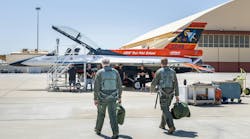Turning over the calendar is generally a time for reflection. A time to look at where you were on Jan.1 and see how far you’ve come. Celebrate milestones hit and goals achieved, and lament what you never got around to but soften with the knowledge that a whole new year of opportunities lies ahead.
In that spirit, let’s look back at a few of the noteworthy moments from the industry this year.
Environmental Challenges and Successes
In October, the Environmental Protection Agency issued an endangerment finding on leaded avgas emissions. While expected, the finding adds to the pressure to find a suitable alternative to 100LL. There currently exists no widely approved drop-in replacement for 100LL, though work is being done to establish one.
Speaking with AMT in the spring, Robert Olislagers, senior coordinator for the Eliminate Aviation Gasoline Lead Emissions (EAGLE) initiative, said the one of the main challenges is the age of the fleet. He said modernizing engines may need to be eventually considered.
“… it behooves us to look at modernizing some of the things that are out there that we’re still not dealing with in terms of modern technology,” Olisagers told AMT. “If we need to start making technological changes, that window is coming up pretty quick because that’s not done overnight either.”
In greener news, sustainable aviation fuel (SAF) took leaps this year.
Most recently on Nov. 19, Gulfstream and Pratt & Whitney Canada demonstrated the first successful completion of a trans-Atlantic flight using 100% SAF. In its 2023 Global Fleet and MRO Market Forecast, the Aeronautical Repair Station Association (ARSA) highlights the need to reduce emission as a major hurdle for the aviation industry.
New Ways to Learn
Last September, the new changes to Part 147 went into effect, making 2023 the first full year that schools have operated under the new guidance. While hard data is yet available as to the initial impact of the changes, in their 2023 mid skills gap report, AAR Corp. sees the changes an opportunity to help the aircraft mechanic shortage.
“Aviation’s decadelong push to strip away requirements, such as training on dope and fabric planes and piston-driven engines from 50 years ago, ended when the new FAA Part 147 regulations went into effect in September 2022. The law updating the standards, passed with bipartisan support in Congress, also removes a seat time requirement that measures competency based on hours, a false equivalency for work readiness, and paves the way for more collaboration between industry, secondary, and post-secondary schools to develop curriculum, new career paths, and additional training locations,” the report states.
Parts Problems
Various issues have plagued aircraft production and maintenance throughout the year. Part issues hampered Boeing 737 Max production early in the year, with lasting impacts for the remainder of 2023.
Discovering that the powdered metals it used could hold contaminants that increase the possibility of corrosion and cracks in its PW1100 engines, Pratt & Whitney has been inspecting the engines sold to airlines since late summer.
The issues strike at a time when the industry is still grappling with the impacts to the supply chain initially brought on by the COVID-19 pandemic.
Ben Funston, vice president of supply chain execution, Boeing Global Services, told AMT in April that supply chain disruption post-COVID has been much deeper, broader, and enduring than previous shocks. In response, MROs have been turning to technology as well as sourcing parts from more local sources.
These are some of the things we saw in 2023. A whole new year of opportunities lies ahead.

